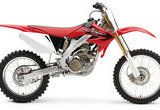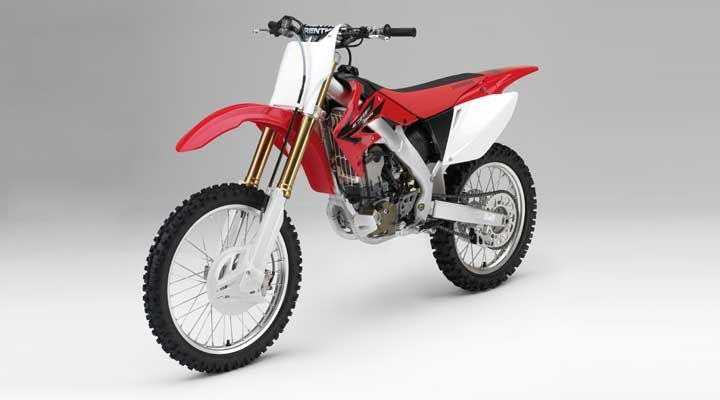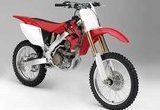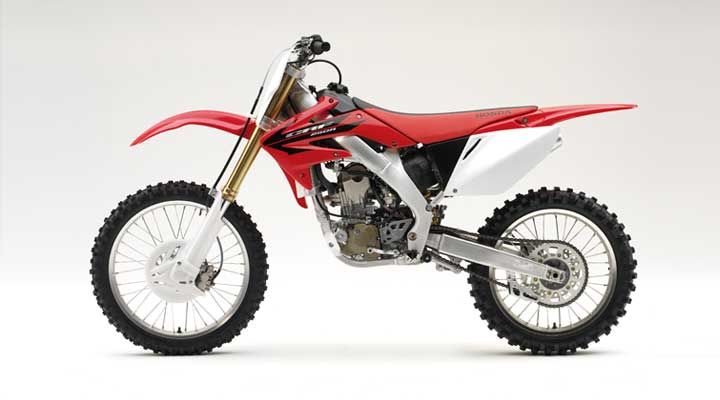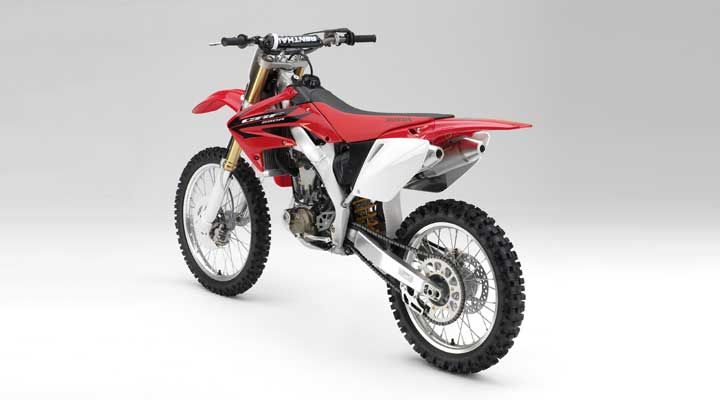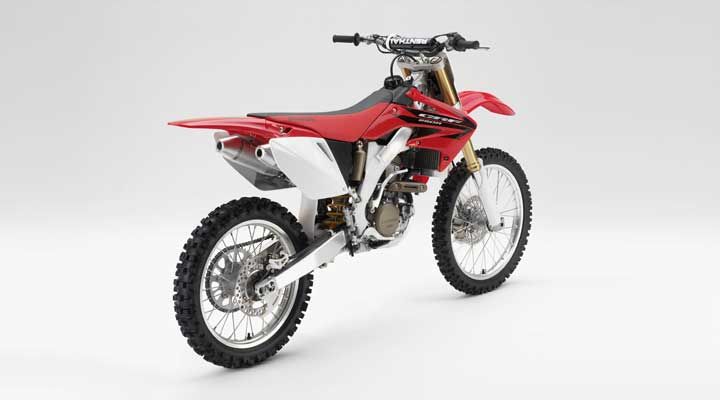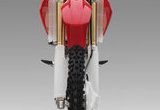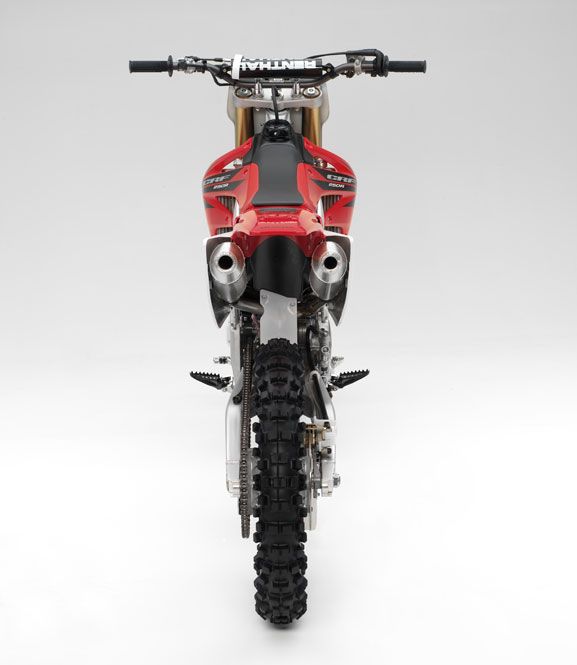With a revolutionary twin-muffler exhaust system that centralizes mass and improves handling in the whoops and rhythm sections, the new CRF250R screams into 2006 with the ultimate, 125-class-conquering combination of huge horsepower (thanks to the twin-pipe and an all-new 40mm carb) and sharper-than-ever track-carving capability. Look for it on podiums all across the country.
2006 Honda CRF250R
- Make: Array
- Model: 2006 Honda CRF250R
- Horsepower: 0@0
Look at the 2006 Honda CRF(R)250R and see the future. Once again, Honda engineers have dared to go where no others would venture, establishing new-think technology. Gaze backward over the history of motorcycles and your mind conjures up images of groundbreaking machines-plenty of them bearing the Big Red H-that firmly establish industry-transforming milestones. In short order, the 2006 Honda CRF250R will join the ranks of these esteemed machines.
Why? Because for 2006, numerous engine modifications boost power in the new CRF250R all through its high-soaring rev range, but these changes can be rightly called evolutionary in nature; they don't introduce sweeping alterations in fundamental engine design. Likewise, the aluminum Honda frame retains its well-proven fourth-generation configuration-excepting the subframe. And it is here, hanging abaft and below the rider, that we find the newest nugget of Honda bright-think: the CRF250R's dual-muffler system, a setup primarily chosen to improve handling, while also enhancing power. And, of course, there's more.
In a nutshell, here's a compilation of what's new for 2006:
- Innovative dual-muffler system for improved handling and performance
- New piston shape with higher compression ratio
- Thinner piston ring
- Reshaped exhaust port
- New camshaft
- 40mm Keihin FCR carburetor replaces last year's 37mm unit
- Revised ignition mapping
- New material for the intake valve seat
- Shorter, lighter fork tubes
- Stronger, lighter front hub
- Radiators repositioned 5mm lower
- New swingarm construction
- Revised valving in rear shock and fork
Back to the beginning.
But before we get ahead of ourselves, let's review how quickly and how far the Honda CRF250R has come since its introduction a mere two seasons ago. Upon its unveiling, the new CRF250R literally rewrote the book on quarter-liter four-strokes. This new machine scaled out a feathery nine pounds lighter than the 2004 Honda CR(R)250R two-stroke-an accomplishment many thought impossible. More than merely a smaller version of the CRF450R, the 2004 CRF250R was an all-new machine, in some ways a generation ahead of the much-lauded 450.
As would be expected with a high-performance machine of smaller displacement, the CRF250R engine revved much higher than the 450 engine. While the big 450 approached the 11,000-plus-rpm level, the 250 could run at engine speeds in excess of 13,000 rpm-stratospheric levels for a single-cylinder engine. So the CRF250R engine design had to incorporate tremendous rigidity in the cylinder head and valve train areas to accommodate such ultra-high engine speeds.
Dual cams in one: Unicam.
The key to this design is Honda's Unicam(R) layout, which allows four valves to function in a lighter cylinder head. This design also offers the advantage of a narrower included valve angle than is possible in a DOHC configuration. Up to this point, conventional wisdom held that rocker-arm systems were unsuited for engine speeds above 10,000 rpm. But the CRF250R achieved engine speeds greater than 13,000 rpm because its rocker arms were designed to be both lightweight and rugged. Other high-tech elements include lightweight titanium intake valves. The exhaust valves are made of high-temperature steel with heat-resistant Inconel(R) alloy used in the neck area just before the flare of the valve head. Inconel alloy contains high levels of nickel and can be thought of as super-stainless steels that have exceptional anti-corrosion and heat-resistance properties. As in the CRF450R, valve-stem diameters measured 5mm and the stem seals were carried over from the 450 as well.
In addition, the 250 piston is quite short overall and its skirt is ultra-short, so it doesn't look much like the pistons generally used in production four-stroke engines. It looks a lot like just a piston crown with a wrist pin attached, with just mere vestigial traces of a piston skirt remaining in two places to prevent the piston from rocking in the cylinder. The forged piston runs in a cylinder impregnated with a tough, low-friction Nikasil(R) lining, a setup that also enhances cooling and reduces weight because it eliminates the use of a cylinder liner. In addition, the 250's connecting rod is double-carburized for extra toughness and it utilizes a needle bearing in the big end to maximize high-rpm performance and increase durability. Likewise, the high-strength, low-carbon steel crankshaft features carburized main journals for maximum durability under high engine speeds.
Other high-tech touches include the use of lightweight magnesium to reduce the weight of the ACG cover, clutch cover and cylinder head cover. Also, the vertically split crankcases feature a built-in oil pump, which reduces weight compared to a conventional design. Like its big-brother CRF450R, the 250 incorporates a twin-sump lubrication system that separates the engine oil from the oil bathing the clutch and the close-ratio five-speed transmission. This dual-supply system ensures a cooler environment for the clutch while also isolating the engine from any potential contamination caused by clutch and transmission material. In addition, because the total volume of oil circulating to the crankshaft, piston and valve train has been reduced, the oil pump supplying these vital parts can be made commensurately smaller and lighter.
The fourth generation of aluminum frames.
Because the CRF250R's engine is so much more compact and lighter than the 450's, the 250's frame proportions could be redesigned correspondingly smaller. So the CRF250R evolved into the next step forward in chassis design compared to both the CRF450R and the two-stroke CR250R.
According to Eiji Adachi, the chassis engineer who developed the CRF250R's fourth-generation aluminum frame, "Many riders seem to think aluminum frames are bound to feel really stiff, but the CRF250R's frame has been tuned to offer a very natural feeling. By adding a bit of thickness here and trimming a little bit off there, we have balanced lightweight agility with frame rigidity. Aluminum has a lower specific gravity compared to steel, so these adjustments are easier to achieve than with comparable steel frames."
This is one of aluminum's great advantages. Material can be added and taken away to gain strength or flexibility in specific areas. Also, because the main spars of Honda's aluminum CR frames are rectangular in cross-section, engineers were free to work with two more variables unavailable to round-tube-steel fabricators. First, they could make the top and bottom sections of the box thicker or thinner than the sidewalls, simply by specifying a change in the extrusion dies. Such changes altered the stiffness of the frame members in a huge way, making them resistant to up-and-down flex, while still allowing side-to-side resilience, both in precise increments.
In working with this fourth-generation aluminum frame, engineers took advantage of the material's amazing tunability throughout the design. The semi-double-cradle design incorporated a forged aluminum steering head. A forged gusset at the rear of the steering head added strength to the entire assembly. This steering head connected to a single, tapered, large-diameter downtube, a slimmed-down and lightened version of the 450's downtube. Freshly designed swingarm pivot plates featured a web of internal gussets for increased strength, and were shaped to create a narrow overall cross-section to optimize rider comfort and enhance maneuverability. But the most visible alterations to the new frame were the main spars connecting the most crucial chassis elements, the steering head and the swingarm pivot. These lightweight aluminum extrusions were decidedly shorter and narrower, and they featured thicker walls than Honda's third-generation aluminum frame.
Given the lighter weight and reduced loads imposed upon the 250, these alterations changed the flex characteristics of the frame to create a chassis that felt softer on bump impact and improved cornering characteristics, while still delivering the solid handling and exemplary level of durability typical of Honda's aluminum frames.
A winning formula for 2005.
All in all, the 2004 CRF250R proved to be a runaway hit with racers, magazine editors and the general public alike, but that was no reason to halt progress; when the 2005 model debuted, it featured a number of the latest racing-derived improvements. A host of changes to the engine enhanced the CRF's performance while also reducing weight. A new swingarm design shaved unsprung weight, and changes to the front end yielded a sharper-turning chassis and plusher suspension action.
These upgrades made a great machine even better, as born out by magazine comparison tests, three of which rated the '05 CRF250R tops in its class: Dirt Rider, TransWorld Motocross and Cycle News.
A milestone year to remember: 2006.
All of which brings us back to 2006, and the accompanying improvements for this new model year. Beginning with the most visible change, the idea of dual mufflers is not brand new, of course. However, past attempts have been abandoned because of an inability to execute the idea in a sufficiently beneficial manner. Enter Honda.
First, thanks to a host of provisions to trim weight, the dual-muffler 2006 CRF250R weighs a trifling 6.5 ounces more than last year's single-can version. For example, the fork tubes have been shortened 7mm to reduce fork weight 2.45 ounces. In previous models, the fork tubes were elongated to accommodate riders who wished to run 20-inch front wheels, but that option has now been eliminated, hence the shorter tubes. A re-engineered swingarm provides additional weight savings-7.56 ounces, to be exact-and other areas for weight reduction include the rear wheel, rear shock and more. As a result, the CRF250R still tips the scales at a mere 204 pounds dry.
Moreover, each of the 2006 CRF250R's dual mufflers is now significantly smaller, shorter and lighter than the previous single silencer, and they tuck in much closer to the machine's center of mass; the trailing edges of the dual mufflers repose a full 95mm (3.74 inches) farther forward than the end of the old single muffler. And these drastic changes that affect where the bike carries this weight produce improvements in mass centralization, so the new exhaust system significantly improves handling.
How so? Consider this: A body in motion, such as a motorcycle, is subject to powerful inertial and gyroscopic forces. A motorcycle's handling and feel are judged by the rider's ability to make course alterations rapidly while the machine is in motion. Directional changes occur in three axes, these movements being called roll, pitch and yaw. In simple terms, roll is rotation about a lengthwise axis, while pitch is the movement occurring when the front and rear of the body in question alternately assume the uppermost position, and yaw is the turning motion around the vertical axis.
Honda's engineers discovered that the change to an exhaust system incorporating a pair of smaller, more centrally located mufflers yields profound improvements in the CRF's handling: a 2 percent improvement in roll characteristics, a remarkable 18 percent reduction in pitch figures and a whopping 28 percent improvement in yaw response. Translated to seat-of-the-pants impressions, the 2006 CRF250R now feels lighter, more responsive and very neutral feeling when riding or jumping.
Dual mufflers, dual patents.
This new design is of such import, Honda's engineers acquired two patents on this innovative exhaust system. One deals with the location of the exhaust pipe as it passes between the rear shock and frame, and over the rear tire, with a split in the pipe coming behind the shock. In addition, the CRF design incorporates two pipes of differing diameters that split off from the 38.1mm main pipe; one pipe is 35mm in diameter, while the other is 31.8mm, and this feature is patented as well.
Other enhancements to handling include moving the radiators 5mm down to lower the center of gravity. New valving in the fork and rear shock improve bump-absorption qualities, and a lighter front hub reduces unsprung weight to also enhance handling.
More power all the time.
In addition, because the CRF250R's new, freer-flowing exhaust system improves low-end power, other engine alterations could be made to boost midrange and top-end power as well. The piston crown now features a more squared-off shape to enhance sealing-a change that helps boost midrange muscle, and the compression ratio has been upped from 12.5:1 to 12.9:1. Also, the compression ring has been narrowed slightly, from 0.9mm to 0.8mm, to reduce power-robbing friction. To boost top-end output, a 40mm flat-slide carburetor with throttle position sensor replaces last year's 37mm unit, the shape of the exhaust port has been altered and the '06 CRF sports a different, hotter camshaft than last year's, one with more exhaust lift (7.7mm to 8.0mm) and 5.0 degrees longer duration. To promote engine longevity, the valve seats on the intake side are now made of a new, tougher material. And recalibrated ignition mapping complements all of the above- listed tuning changes.
Net result: more power all through the rev range, and a chassis package that firmly sets the new benchmark for handling. The 2006 Honda CRF250R is sure to make its mark on the upcoming racing season, but even bigger yet, this is a machine that truly marks a new era in motorcycle design.

